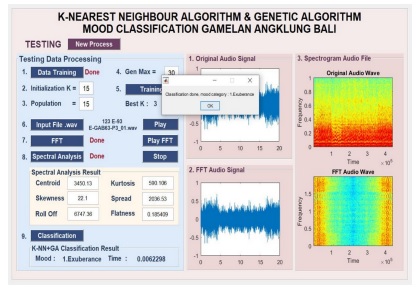Sistem Klasifikasi Musik Gamelan Angklung Bali Terhadap Suasana Hati Menggunakan Algoritma K-Nearest Neighbor Berbasis Algoritma Genetika
Abstract
Balinese gamelan angklung instrumental music through its sound waves can interfere the waves of human’s thought to decrease brain’s wave frequency. The aim is to affect the psychological condition in term of mood so it will lead to positive stress level with either low or high energy. Music with positive stress level and low energy level is categorized as contentment. Positive stress level music and high energy level is categorized as exuberance. MIR (Music Information Retrieval) is a part of Data Mining which digging information about music’s data. One of them is the mood’s classification which is interpreted by chunks of music data. This research designs and builds the classification system to detect the Balinese gamelan angklung instrumental music’s mood using K-NN algorithm and K-NN based Genetic Algorithm. K-NN is able to overcome the classification problem well. However, behind its excellence, the very sensitive k value setting becomes a weakness. Applying Genetic Algorithm on the K-NN classification system optimizes the optimal k value’s determination. Based on the same training and testing data set, K-NN gives 81,08% (k=6) as the highest accuracy percentage, while K-NN based Genetic Algorithm gives 89,19% (k=4) as the highest accuracy percentage.
Downloads
References
[2] G. Harsemadi, M. Sudarma, and N. Pramaita, “Implementasi Algoritma K-Nearest Neighbor pada Perangkat Lunak Pengelompokan Musik untuk Menetukan Suasana Hati,” Maj. Ilm. Teknol. Elektro, vol. 16, no. April, pp. 14–20, 2017.
[3] W. J. Shudiq, “Penerapan K-Nearest Neighbor Berbasis Algoritma Genetika untuk Klasifikasi Mutu Padi Organik,” Pros. SNATIF Univ. Muria Kudus, pp. 121–126, 2017.
[4] H. Harafani, “Optimasi Algoritma Genetika Pada K-Nn Untuk Memprediksi Kecenderungan ‘Blog Posting,’” J. Pendidik. Teknol. dan Kejuru., vol. 15, no. 1, pp. 20–29, 2018.
[5] P. Seni, S. Rupa, U. Gadjah, and M. Yogyakarta, “Kosmologis Tetabuhan dalam Upacara Ngaben,” vol. 15, no. 2, pp. 107–125, 2014.
[6] I. W. Suharta, “Pengembangan Gamelan Angklung Sebagai Pengiring Paket Seni Pertunjukan Wisata,” Semin. Nas. Fak. Seni Pertunjuk., pp. 67–75, 2019.
[7] I. M. Bandem, “Suasana Hati Gamelan Angklung Bali,” 2018, Wawancara: Mei 2018, Jl. Sandat, Denpasar.
[8] F. Zhouyu, L. Guojia, T. Kaiming, and Z. Dengsheng, “A Survey of Audio-Based Music Classification and Annotation,” IEEE Trans. Multimed., vol. 13, no. 2, pp. 303–319, 2011.
[9] A. Vidyawati and M. Hasanah, “Efektivitas Musik Klasik Untuk Menciptakan Suasana Hati Positif Pada Siswa Smp Semen Gresik,” PSIKOSAINS (Jurnal Penelit. dan Pemikir. Psikologi), vol. 14, no. 1, p. 71, 2019.
[10] X. Hu, “Music and mood: Where theory and reality meet,” Proc. iConference, pp. 1–8, 2010.
[11] P. Ekkekakis, “The measurement of affect, mood, and emotion in exercise psychology,” Meas. Sport Exerc. Psychol., pp. 321–332, 2012.
[12] R. Y. Sipasulta, A. S. M. L. St, and S. R. U. A. Sompie, “Simulasi Sistem Pengacak Sinyal Dengan Metode FFT (Fast Fourier Transform ),” E-journal Tek. Elektro dan Komput., pp. 1–9, 2014.
[13] A. Lerch, An introduction to audio content analysis: Applications in signal processing and music informatics. 2012.
[14] F. D. Septria, N. Ibrahim, F. T. Elektro, and U. Telkom, “Klasifikasi Emosi Berdasarkan Sinyal Suara Manusia Menggunakan Metode Key-Nearest Neighbor (K-NN),” e-Proceeding Eng., vol. 6, no. No. 2 Agustus, pp. 4130–4138, 2019.
[15] A. Mutoi Soregar, Amril; Puspabhuana, Data Mining Pengolahan Data Menjadi Informasi dengan RapidMiner. Surakarta: Kekata Publisher, 2017.
[16] S. Maulik, Ujjwal; Bandyopadhyay, “Genetic algorithm-based text clustering technique,” Genet. algorithm-based Clust. Tech., vol. 4221 LNCS, pp. 779–782, 2000.
[17] I. M. (Fakultas T. U. U. Suwija Putra, “Penerapan Algoritma Genetika dan Implementasi dalam Matlab,” 2018.
[18] P. dkk. Suwirmayanti, “Optimasi Pusat Cluster K-Prototype dengan Algoritma Genetika,” Maj. Ilm. Teknol. Elektro, vol. 13, no. Juli-Desember, pp. 16–23, 2014.
[19] A. Banjarsari, Mutiara Ayu; Budiman, Irwan; Farmandi, “Penerapan K-Optimal Pada Algoritma Knn Untuk Prediksi Kelulusan Tepat Waktu Mahasiswa Program Studi Ilmu Komputer Fmipa Unlam Berdasarkan Ip Sampai Dengan Semester 4,” Klik - Kumpul. J. Ilmu Komput., vol. 2, no. 2, pp. 159–173, 2015.
[20] I. A. Angreni, S. A. Adisasmita, M. I. Ramli, and S. Hamid, “Pengaruh Nilai K Pada Metode K-Nearest Neighbor (Knn) Terhadap Tingkat Akurasi Identifikasi Kerusakan Jalan,” Rekayasa Sipil, vol. 7, no. September, pp. 63–70, 2018.


This work is licensed under a Creative Commons Attribution-NonCommercial-NoDerivatives 4.0 International License.

This work is licensed under a Creative Commons Attribution 4.0 International License




